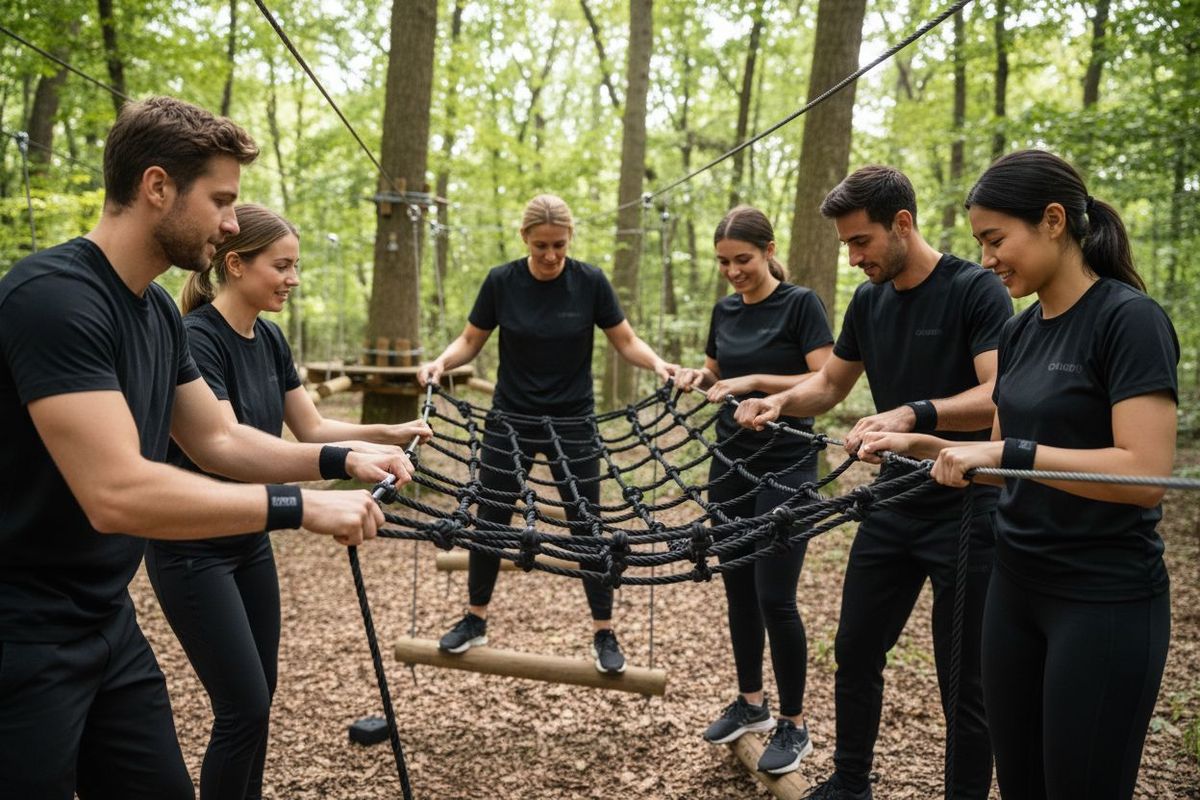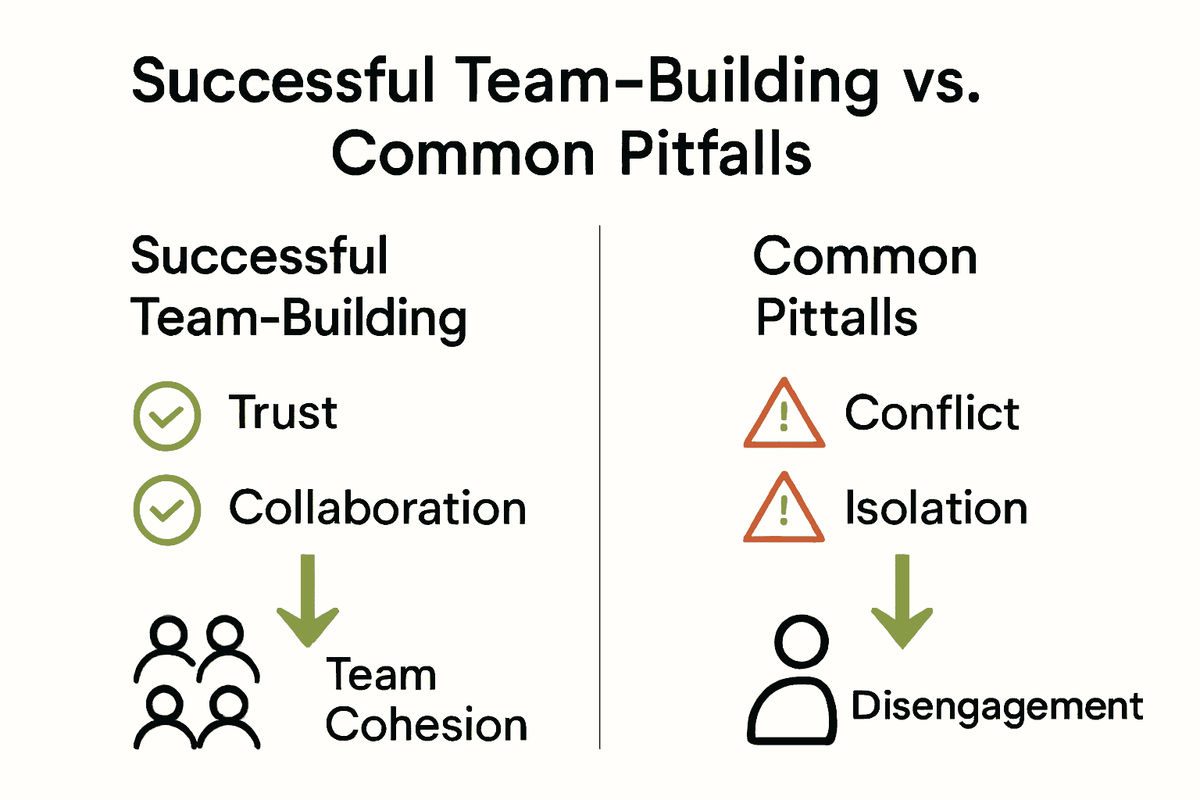Complete Guide to Successful Team-Building Tips
October 16, 2025

Did you know that teams with high trust levels outperform others by nearly 50 percent? Building a strong team goes far beyond fun outings or scheduled company events. Real progress starts when team members feel genuinely connected and valued, which cannot happen through one-off activities alone. Understanding the real impact of team-building, common myths, and the key traits that make collaboration work gives any group the power to transform their results.
Key Takeaways
| Point | Details |
|---|---|
| Ongoing Process | Successful team-building is a continuous effort, focusing on cultivating trust and collaboration rather than a one-time event. |
| Tailored Activities | Effective initiatives require customized strategies that align with team dynamics and individual personalities for meaningful engagement. |
| Inclusive Environment | Prioritizing psychological safety allows team members to share vulnerabilities and foster genuine connections, enhancing team cohesion. |
| Embrace Technology | Integrating digital tools and gamified approaches can enhance interaction but should complement authentic engagement rather than replace it. |
Table of Contents
- Defining Successful Team-Building And Misconceptions
- Core Types Of Team-Building Activities Explained
- Key Elements Of Effective Team-Building Initiatives
- Integrating Technology And Game-Based Approaches
- Common Team-Building Pitfalls And How To Avoid Them
Defining Successful Team-Building and Misconceptions
Successful team-building isn't just about hosting occasional pizza parties or mandatory corporate retreats. It's a strategic approach to creating deeper connections, enhancing communication, and improving overall team performance. Many managers misunderstand team-building as a one-time event, when in reality, it's an ongoing process of cultivating trust, understanding, and collaborative skills.
Common misconceptions about team-building often derail organizational efforts. Managers frequently assume that:
- Team-building happens automatically through daily work interactions
- Expensive activities guarantee meaningful connections
- Introverted team members won't benefit from group activities
- Success can be measured solely through immediate productivity metrics
The truth is more nuanced. Effective team-building requires intentional design, understanding individual team dynamics, and creating environments where everyone feels valued and heard. Learn more about defining team-building success through structured, engaging experiences that go beyond surface-level interactions.
Ultimately, successful team-building transforms groups of individuals into cohesive units with shared goals, mutual respect, and enhanced collaborative capabilities. It's not about forcing connections but facilitating natural, meaningful interactions that strengthen professional relationships and drive collective performance.
Core Types of Team-Building Activities Explained
Team-building activities come in diverse formats, each designed to address specific organizational needs and team dynamics. Communication-focused activities are foundational, helping teams break down barriers and develop more transparent, effective interaction patterns. These might include structured dialogue exercises, problem-solving challenges, or interactive workshops that require collaborative communication strategies.
Another critical category is problem-solving and strategic activities, which test a team's collective ability to navigate complex scenarios. These often involve:
- Simulated business challenges
- Puzzle-based group exercises
- Scenario planning workshops
- Cross-functional collaboration scenarios
Trust-building and relationship-oriented activities focus on creating deeper interpersonal connections. Explore different team bonding techniques that go beyond traditional workplace interactions. These activities might include outdoor adventure experiences, storytelling sessions, personality assessment workshops, or creative collaboration projects that reveal team members' unique strengths and perspectives.
Physical and high-energy experiential activities provide another powerful team-building approach. These activities intentionally push teams out of their comfort zones, creating memorable shared experiences that translate into improved workplace dynamics. Whether it's a charity team challenge, a competitive group sport, or an immersive role-playing scenario, these experiences help teams develop resilience, mutual understanding, and collective problem-solving skills.

Here's a comparison of the core types of team-building activities:
| Activity Type | Main Purpose | Example Activities |
|---|---|---|
| Communication-Focused | Improve team interaction | Dialogue exercises Workshops Problem-solving tasks |
| Problem-Solving & Strategic | Boost collective thinking | Simulations Puzzle games Scenario planning |
| Trust-Building & Relationship | Strengthen interpersonal ties | Storytelling Personality workshops Creative projects |
| Experiential (Physical/Energy) | Foster resilience & bonding | Sports Charity challenges Role-playing |
Key Elements of Effective Team-Building Initiatives
Intentional design is the cornerstone of successful team-building initiatives. Organizations must approach these programs with strategic precision, moving beyond generic activities to create meaningful experiences that directly address specific team dynamics and organizational goals. This means carefully selecting activities that align with the team's unique challenges, communication patterns, and professional development needs.
Key elements that distinguish exceptional team-building initiatives include:
- Clear, measurable objectives
- Alignment with organizational culture
- Inclusive design that considers diverse team member personalities
- Opportunities for genuine skill development
- Mechanisms for ongoing feedback and improvement
Psychological safety emerges as a critical component of effective team-building. Explore cutting-edge team building strategies that prioritize creating environments where team members feel comfortable taking risks, sharing vulnerabilities, and expressing innovative ideas without fear of judgment. This approach transforms team-building from a superficial exercise into a profound mechanism for organizational growth.
Successful initiatives also recognize that team-building is an ongoing process, not a one-time event. They integrate continuous learning, periodic assessment, and adaptive strategies that evolve with the team's changing dynamics. By combining structured activities, reflective practices, and opportunities for genuine connection, organizations can create team-building experiences that genuinely transform group interactions and collective performance.
Integrating Technology and Game-Based Approaches
Digital team-building transforms traditional interaction models by leveraging interactive technologies that make collaboration more engaging and dynamic. Modern organizations are increasingly recognizing the power of game-based approaches to break down communication barriers, create shared experiences, and develop critical workplace skills in a low-pressure, entertaining environment.
Technology-enabled team-building strategies offer multiple innovative approaches:
- Interactive quiz platforms
- Virtual reality collaboration scenarios
- Multiplayer problem-solving simulations
- Competitive digital challenges
- Remote team engagement tools
Gamification principles are particularly powerful in creating meaningful team interactions. Discover strategies for designing effective team collaboration games that transform traditional learning and development approaches. These digital experiences can simulate complex workplace scenarios, allowing teams to practice communication, strategic thinking, and collective decision-making in immersive, risk-free environments.
The key to successful technology integration lies in balancing digital interaction with genuine human connection. While game-based approaches provide exciting new tools for team development, they must be thoughtfully designed to complement rather than replace authentic interpersonal engagement. By selecting technologies that promote genuine interaction, encourage active participation, and align with team learning objectives, organizations can create powerful team-building experiences that are both enjoyable and transformative.
Common Team-Building Pitfalls and How to Avoid Them
One-size-fits-all approaches frequently undermine team-building efforts, creating experiences that feel forced and inauthentic. Many organizations mistakenly believe that generic activities will magically resolve complex team dynamics, overlooking the unique characteristics and needs of their specific workforce. Effective team-building requires nuanced, tailored strategies that consider team composition, organizational culture, and individual personalities.
Common team-building pitfalls include:
- Mandatory participation without clear objectives
- Activities that feel disconnected from workplace realities
- Insufficient preparation and follow-up
- Overlooking introverted team members' comfort levels
- Focusing solely on fun without learning outcomes
Psychological resistance can dramatically undermine team-building initiatives. Learn about advanced strategies to overcome team-building challenges that address underlying team dynamics and individual reservations. Successful programs recognize that genuine team connection cannot be forced but must be carefully cultivated through thoughtful, inclusive, and meaningful experiences.
To truly transform team interactions, organizations must move beyond superficial activities and create environments of genuine psychological safety. This means designing experiences that allow team members to voluntarily engage, share vulnerabilities, and develop authentic connections. By prioritizing meaningful dialogue, recognizing individual contributions, and creating low-pressure collaborative opportunities, teams can develop the trust and mutual understanding that drive exceptional collective performance.

Transform Team-Building Challenges into Real Engagement
Is your team tired of generic team-building activities that never quite resonate? Many organizations, as discussed in the article, struggle with one-size-fits-all solutions that miss the mark and leave employees feeling disconnected. The real challenge is finding an approach that goes beyond surface-level fun to build genuine collaboration, psychological safety, and ongoing communication—just what your workplace needs.

Now is the perfect time to rethink your team-building strategy with a proven, customizable platform. Quizado gives you access to interactive, quiz-based team-building games modeled after popular shows. You can create your own branded experiences, adapt activities for both online and in-person events, and leverage a full quiz question bank to spark lasting engagement. Ready to turn passive participation into active team pride? Take advantage of these tools today—because successful teams are built through thoughtful, genuine connection. Visit Quizado's homepage and discover how easy team-building can truly be.
Frequently Asked Questions
What are the key elements of effective team-building initiatives?
Effective team-building initiatives include intentional design, clear measurable objectives, alignment with organizational culture, inclusive design for diverse personalities, opportunities for genuine skill development, and mechanisms for ongoing feedback and improvement.
How can technology enhance team-building activities?
Technology can enhance team-building activities by integrating digital platforms that promote interactive collaboration, such as virtual reality scenarios, multiplayer simulations, and game-based approaches that foster engagement and connection among team members.
What are common misconceptions about team-building?
Common misconceptions include the belief that team-building occurs automatically through daily interactions, expensive activities guarantee meaningful connections, introverts won’t benefit from group activities, and that success can be measured solely by immediate productivity metrics.
How can organizations create psychological safety during team-building?
Organizations can create psychological safety by designing experiences that encourage team members to share vulnerabilities, engage in meaningful dialogue, and contribute authentically, all while ensuring that individual comfort levels are respected.



